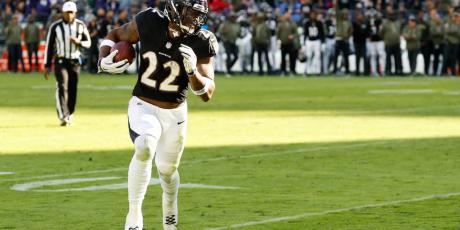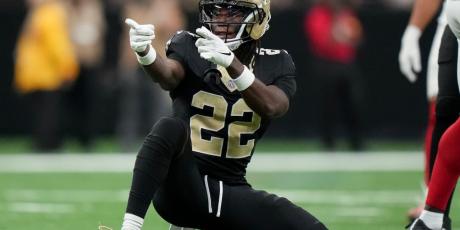Wide Receiver Sleepers, Values, and Targets

I’d argue that the receiver position is more affected by the scoring system (PPR vs. standard) and roster settings (two WRs vs. three-plus WRs) than any other position. Take the top 24 players in Relative Value in two different formats:
- In a top-200 rankings list for a 12-team standard scoring league with a 1/2/2/1 roster, four WRs are in the top 24.
- In a top-200 rankings list for a 12-team PPR league with a 1/2/3/1 roster, eight WRs are in the top 24. Moreover, there are five WRs in the first round.
My point? Be sure that you enter your league’s settings into the 4for4 customizable tools to ensure that you have an understanding of how scoring affects positional value in your particular league. It may affect the way you want to approach your draft.
Note: It’s important to remember that our Top 200 rankings are derived via a formula and do not necessarily represent the optimal way to approach any given draft. We’re confident that owners who draft straight from the custom Top 200 rankings will field a competitive team, but there are other factors (positional dependability, using ADP to your advantage, etc.) that can help owners gain an extra edge and win their league. Be sure to read our ongoing and upcoming draft strategy articles; they should help you formulate a strategy for your specific draft(s).
More Positional Sleepers: QB | RB | TE
Site-Specific Sleepers: Yahoo | ESPN | NFL.com | CBS
Below are four sections:
- Targets (players I’m actively trying to get in every draft)
- Values (5th–9th round targets)
- Sleepers (10th–15th round targets)
- Deep Sleepers (16th round or later targets)
For the purpose of this article, I’ll use 4for4’s multi-site ADP (12-team). Readers who have been active in MFL10 drafts will notice some eyebrow-raising ADP numbers below. MFL10 ADP tends to be much sharper and ahead of the curve than major-site ADP, so it’s a good indication of where that major-site ADP is probably headed.
Targets
Larry Fitzgerald, Cardinals (in the third round)
Fitzgerald turns 35 in August, but that hasn’t stopped him from posting three straight finishes inside the top 11 in PPR formats, and inside the top 17 in standard leagues. He is third in total targets (311) over the last two seasons, behind only DeAndre Hopkins and Antonio Brown. He has caught at least 107 passes, 1,023 yards, and 6 touchdowns in each of the last three seasons, and if he’s able to hit all of those benchmarks again, he’s looking at another WR1 finish in PPR leagues. With both John Brown and Jaron Brown departing via free agency, and noted short-ball enthusiast Sam Bradford throwing the ball, Fitzgerald should see another 160 targets in 2018.
Golden Tate, Lions (in the fourth round)
Since arriving in Detroit in 2014, Tate has an average PPR finish of 16.0 and has never finished lower than No. 23. He has averaged 132 targets in that span and has the 10th-most targets over the past two seasons. Eric Ebron is gone, so Tate may actually see an increase in targets in 2018. Tate is a terrific middle-round pick, especially in PPR formats.
Michael Crabtree, Ravens (in the sixth round)
Owners should generally exercise caution when drafting free agent receivers, as they tend to disappoint unless they’re either getting a promotion (i.e. more targets) or experiencing an upgrade at quarterback. The (soon-to-be) 31-year-old Crabtree is coming off of a No. 31 overall finish, but he missed two games. Had he played a full 16-game season, he would have finished as a low-end WR2. Of the Ravens’ five most-targeted receivers, only Javorius Allen (60) is back, so there is a boatload of targets up for grabs. Last year, Mike Wallace led the Ravens with 92 targets, but back in 2016, the Ravens had three players with at least 100 targets (Wallace, Dennis Pitta, and Steve Smith), so Crabtree should see 120+ targets as the team’s clear No. 1 receiver. At his three-year fantasy points per target rate (1.62/target), 120 targets would equate to low-end WR2 numbers. He’s currently being drafted as a high-end fantasy WR3.
Robby Anderson, Jets (in the eighth round)
Considering his No. 18 finish last year in PPR formats (No. 15 in standard leagues), Anderson’s stock remains depressed, mainly due to the potential suspension that still looms stemming from a reckless driving charge in January. But given that most of the charges against him were dropped, any suspension would likely be very short (two games?), so Anderson’s 2018 outlook should remain relatively unchanged. In 13 games with returning starter Josh McCown, Anderson averaged 4.0 catches for 65 yards and 0.54 touchdowns, drawing a 42.0 percent share of McCown’s air yards. He’s a tremendous value in the ninth round.
Randall Cobb, Packers (in the ninth round)
In his last 21 games with Aaron Rodgers, Randall Cobb has averaged 5.1 catches for 56 yards and 0.43 touchdowns (on 7.3 targets). Those are solid WR2 numbers in PPR leagues and low-end WR2 numbers in standard leagues. With Jordy Nelson no longer around, Cobb’s targets should increase a bit, assuming he can stay healthy. He’s currently the 37th receiver off the board, so there’s considerable value with Cobb right now.
Sterling Shepard, Giants (in the 10th round)
Continue reading to see why John is targeting Sterling Shepard, who else he is targeting at the wide receiver position this year, and which pass-catchers make up his values and sleepers lists...

- All Premium Content
- The most Accurate Rankings Since 2010
- Expert Draft Picks w/DraftHero
- Highest Scoring Lineup + Top Available Players w/LeagueSync
- ...and much much more






















